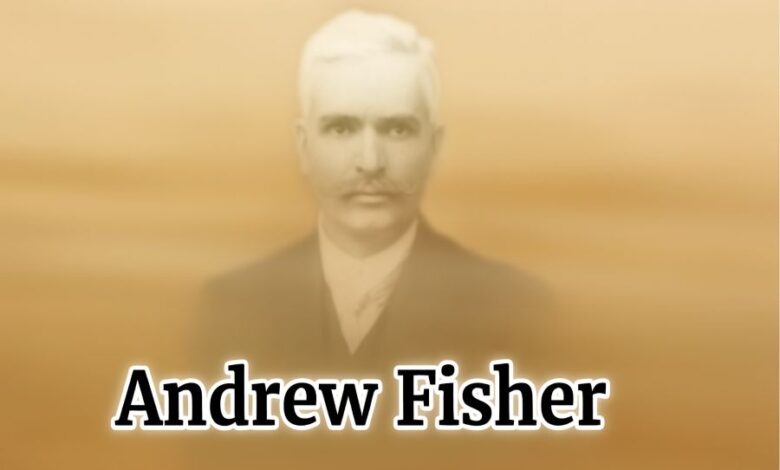Andrew Fisher: The Visionary Prime Minister Who Shaped Modern Australia
From Scottish Miner to Nation-Builder and Labor Icon

Table of Contents
ToggleIntroduction
Andrew Fisher was a man who rose from the coal mines of Scotland to the highest office in Australia. Known for his unwavering principles, humility, and progressive vision, Fisher transformed Australia’s social and economic landscape during his three terms as Prime Minister. His leadership established institutions that still define Australian life today, earning him the title of a true “nation-builder.”
Quick Bio
| Attribute | Details |
|---|---|
| Full Name | Andrew Fisher |
| Date of Birth | 29 August 1862 |
| Birthplace | Crosshouse, Ayrshire, Scotland |
| Nationality | Australian (by naturalization) |
| Ethnicity | Scottish |
| Religion | Presbyterian background |
| Education | Largely self-taught; attended night school |
| Parents | Robert Fisher and Jane Garvin |
| Spouse | Margaret Jane Irvine |
| Children | Six |
| Occupation | Politician, Unionist, Engine Driver |
| Date of Death | 22 October 1928 (London, England) |
| Political Party | Australian Labor Party |
Early Life and Education
Andrew Fisher was born in 1862 in a small mining village in Scotland. His father was a coal miner, and his family lived under tough conditions that shaped Fisher’s early understanding of hard work and justice. With minimal formal education, he devoted himself to learning through books borrowed from a cooperative store library established by his father.
At just ten years old, Fisher began working in the mines to support his family. By the age of seventeen, he had become secretary of the local miners’ union, showing early signs of leadership and commitment to workers’ rights. His Scottish upbringing gave him discipline and empathy for the working class, qualities that would later define his political career.
Migration to Australia and Early Struggles
In 1885, Fisher migrated to Queensland, Australia, seeking new opportunities. He initially worked in coal and gold mines, particularly around Gympie, and earned an engine driver’s certificate in 1891. His deep involvement in labor organizations led him to become president of the Amalgamated Miners’ Association and a founding member of Queensland’s early Labor movement.
Despite his humble beginnings, Fisher’s intelligence, honesty, and organizational skills earned him the respect of miners and union members. His ability to articulate workers’ concerns made him a natural political leader in a rapidly changing Australia.
Political Career and Rise to Power
Fisher entered politics in 1893 when he won a seat in the Queensland Legislative Assembly representing Gympie as a Labor member. Though he briefly lost his seat in 1896, he regained it in 1899 and was appointed Minister for Railways and Public Works in the world’s first parliamentary Labor government, led by Anderson Dawson.
After Australia’s Federation in 1901, Fisher was elected to the federal parliament as the member for Wide Bay. His dedication and leadership saw him rise quickly within the Labor Party. By 1907, he succeeded Chris Watson as party leader, guiding Labor through one of its most transformative eras.
Prime Ministership: Three Terms of Nation Building
First Term (1908–1909)
Fisher first became Prime Minister in 1908, leading a minority government. Though brief, his initial tenure laid the foundation for future reform. His administration advanced legislation for fair wages and chose Canberra as the site for Australia’s national capital, reflecting his long-term vision for a unified nation.
Second Term (1910–1913)
This period marked the peak of Fisher’s influence. Under his leadership, the Labor Party won a clear majority in both houses — the first in Australian history. His government created enduring national institutions:
-
Establishment of the Commonwealth Bank of Australia
-
Introduction of Maternity Allowances
-
Expansion of Old-Age and Invalid Pensions
-
Initiation of the Trans-Australian Railway project
-
Transfer of the Northern Territory to Commonwealth control
Fisher also introduced progressive labor laws, improving workplace safety, wages, and social welfare. His administration’s achievements earned him a lasting reputation as a reformer dedicated to equality and opportunity.
Third Term (1914–1915)
Fisher’s third term coincided with the outbreak of World War I. It was during this turbulent time that he famously declared Australia would support Britain “to the last man and the last shilling.” His government organized Australia’s first major military force, the Australian Imperial Force (AIF), which served bravely at Gallipoli and other fronts.
However, the strain of wartime leadership and poor health forced Fisher to resign in October 1915. His decision demonstrated humility and self-awareness — qualities that defined his leadership style.
Later Life and Diplomatic Service
After resigning, Fisher became Australia’s High Commissioner to the United Kingdom in 1916. In this role, he represented Australian interests during the final years of World War I and participated in the Dardanelles Commission inquiry.
He retired from public life in 1921 but remained in London. His health declined in later years, and he passed away on 22 October 1928. Fisher was laid to rest in Hampstead Cemetery, London, honored by both British and Australian leaders.
Legacy and Impact
Andrew Fisher’s legacy continues to shape modern Australia. His policies helped establish a strong national identity and stable economic framework. The Commonwealth Bank, social welfare programs, and infrastructure he introduced became the backbone of Australia’s prosperity.
He was a man of integrity, compassion, and foresight — a leader who believed that government should serve the common good. Fisher’s name lives on in the Division of Fisher in Queensland and Fisher suburb in Canberra, both tributes to his immense contribution to Australian democracy.
Conclusion
Andrew Fisher’s journey from the coal mines of Scotland to the Prime Minister’s office is a story of determination, justice, and vision. He proved that leadership is not born from privilege but from purpose and conviction. His reforms laid the groundwork for Australia’s modern social and economic systems, making him one of the most transformative leaders in the nation’s history.
FAQs
1. Who was Andrew Fisher?
Andrew Fisher was an Australian Prime Minister and Labor leader who served three terms between 1908 and 1915, known for major social and economic reforms.
2. Where was Andrew Fisher born?
He was born in Crosshouse, Ayrshire, Scotland, in 1862.
3. What were Fisher’s greatest achievements?
He established the Commonwealth Bank, introduced maternity and pension benefits, and initiated the Trans-Australian Railway.
4. When did Andrew Fisher die?
He died in London on 22 October 1928 at the age of 66.
5. Why is Andrew Fisher remembered today?
He is remembered as a nation-builder who championed fairness, progress, and opportunity for all Australians.



